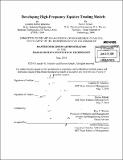| dc.contributor.advisor | Roy E. Welsch. | en_US |
| dc.contributor.author | Infantino, Leandro Rafael | en_US |
| dc.contributor.author | Itzhaki, Savion | en_US |
| dc.contributor.other | Sloan School of Management. | en_US |
| dc.date.accessioned | 2010-10-12T16:23:41Z | |
| dc.date.available | 2010-10-12T16:23:41Z | |
| dc.date.copyright | 2010 | en_US |
| dc.date.issued | 2010 | en_US |
| dc.identifier.uri | http://hdl.handle.net/1721.1/59122 | |
| dc.description | Thesis (M.B.A.)--Massachusetts Institute of Technology, Sloan School of Management, 2010. | en_US |
| dc.description | Cataloged from PDF version of thesis. | en_US |
| dc.description | Includes bibliographical references (p. 59). | en_US |
| dc.description.abstract | The purpose of this paper is to show evidence that there are opportunities to generate alpha in the high frequency environment of the US equity market, using Principal Component Analysis (PCA hereafter) as a basis for short term valuation and market movements prediction. The time frame of trades and holding periods we are analyzing oscillate between one second to as high as 5 minutes approximately. We particularly believe that this time space offers opportunities to generate alpha, given that most of the known quantitative trading strategies are implemented in two different types of time frames: either on the statistical arbitrage typical type of time frames (with valuation horizons and trading periods in the order of days or weeks to maybe even months), or in the purely high frequency environment (with time frames on the order of the milliseconds). On the latter strategies, there is really not much intention to realize equity valuations, but rather to benefit from high frequency market making, which involves not only seeking to earn profit from receiving the bid/ask spread, but also from the transaction rebates offered by the numerous exchanges to those who provide liquidity. We believe that there are more opportunities to capture existing inefficiencies in this arena, and we show how with very simple mathematical and predictive tools, those inefficiencies can be identified and potentially exploited to generate excess returns. The paper describes our underlying intuition about the model we use, which is based on the results of short term PCA's on equity returns, and shows how these results can predict short term future cumulative returns. We randomly selected 50 of the most liquid equities in the S&P 500 index to test our results. | en_US |
| dc.description.statementofresponsibility | by Leandro Rafael Infantino [and] Savion Itzhaki. | en_US |
| dc.format.extent | 59 p. | en_US |
| dc.language.iso | eng | en_US |
| dc.publisher | Massachusetts Institute of Technology | en_US |
| dc.rights | M.I.T. theses are protected by
copyright. They may be viewed from this source for any purpose, but
reproduction or distribution in any format is prohibited without written
permission. See provided URL for inquiries about permission. | en_US |
| dc.rights.uri | http://dspace.mit.edu/handle/1721.1/7582 | en_US |
| dc.subject | Sloan School of Management. | en_US |
| dc.title | Developing high-frequency equities trading models | en_US |
| dc.type | Thesis | en_US |
| dc.description.degree | M.B.A. | en_US |
| dc.contributor.department | Sloan School of Management | |
| dc.identifier.oclc | 658860705 | en_US |
